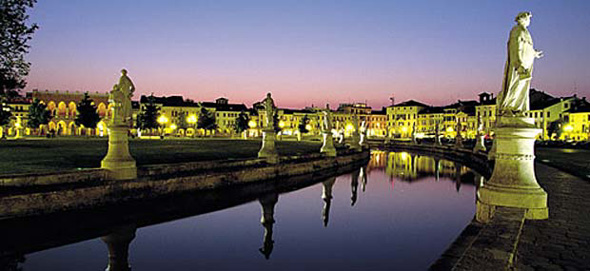 |
The city's standing and importance
 |
|
Padua, piazza del Prato della Valle
|
 |
A complete overview of Padua in the period when Giotto
painted the Scrovegni Chapel was recently illustrated in a major exhibition
entitled "Giotto e il suo tempo" (Giotto and his time), held
in Padua in April 2001. This section refers to the exhibition catalogue
which contains articles by some of the leading scientific and historical
experts in the field.
The context in which the Chapel's wall paintings were carried out has
a number of well-defined characteristics which have only recently been
pointed out.
From around 1260 onwards, Padua underwent exceptional changes in terms
of its political, military and diplomatic roles in the Veneto mainland
region. And its position became even more important in the years immediately
preceding Giotto's arrival in the city.
Padua had become a major urban centre, and with its 30,000 or more inhabitants,
it was among the top fifteen cities in Italy. The constantly increasing
population, the city's urban expansion, its solid hold over its fertile
and populous surroundings, the wide range of production activities and
the mobility of its social classes - all this went hand in hand with an
energetic move to enlarge its territorial boundaries. This process started
with heavy interference in the affairs of Vicenza which eventually became
a protectorate, later becoming outright domination (1266-1311), followed
by the annexation of Bassano and of Valsugana in 1272, and of Lonigo in
1281.
In the late 13th and early 14th centuries, there was a further a further
speeding up of expansion towards the south - initially by taking over
the towns of Badia Polesine and Lendinara in the period 1292-1294; then
with the occupation of Rovigo in 1308.
At the turn of the century, Padua had become
a focal point for the Guelph forces in north-eastern Italy. Ordinary people,
local councils, principalities, ecclesiastical figures and politicians
in the Venice area looked to Padua as a natural bulwark of republican
freedom against the threatening advance of feudal rulers such as the Della
Scala and Visconti families, and the city was also seen as a symbol of
orthodoxy and loyalty to the papacy.
Through the strength of its intellectual resources, largely due to the
presence of one of the earliest and most important universities in Europe,
Padua was able to make its influence felt in no uncertain terms on the
towns of Vicenza, Belluno, Feltre, Trento, Rovigo, Udine, Cividale, Trieste,
by transferring large numbers of soldiers, judges, notaries, professors,
doctors, priests, and so on, to these occupied areas.
This unique golden age for Padua created enormous wealth and a heady whirl
of investments with enormous opportunities to make money for large parts
of the population. But the most significant fact was the city had stepped
beyond a purely regional dimension, and was no longer shut off from the
rest of the country in its rhythms and prospects.
Cultural exchanges
When Giotto arrived in Padua, the city had become a point of reference
in a wide-ranging system of relationships and alliances that also touched
on the Papal States and covered the whole territory of Tuscan-Padua with
strong links to cities like Bologna and Florence.
This accelerated process of expanding beyond a provincial dimension has
left many traces, some of which regard sociological and cultural aspects.
There were certainly many cultural exchanges in the fields of sculpture
and architecture, as shown by the statues that Giovanni Pisano made for
the Scrovegni Chapel, around 1304; or the figure of "magister murarius"
(master-builder) Leonardo Bocaleca, less well-known but no less able,
or Giovanni degli Eremitani, who was responsible for a spate of public
building activity in Padua in the late 13th and early 14th centuries.
We know that Bocaleca was not only an architect, designing the "Palazzo
degli Anziani" in Padua, but also an engineer, specialised in water
supply and military fortifications, who designed and built the Castelbaldo
fortress. His work should be seen in relation to Arnolfo di Cambio.
Padua also played an international role not only by virtue of its University
which was attended by the likes of Marsilio da Padua and Pietro
d'Abano, but also in music
with Marchetto, and in the painting of miniatures,
a sector that would develop throughout the 1300s.
From 1328 to 1337, Padua went through a period of political crisis after
falling into the hands of the Scaligeri family. There was also a lull
in artistic activity at this time. The city once again came under the
Carrara family in 1338, and Ubertino, ruler of Padua until 1345, began
the construction of a large palace, commissioning a number of art works.
This renewed patronage of the arts was to reach a peak under Francesco
I from 1350 onwards. All in all, it was an interesting period which was
then brusquely interrupted when Padua was conquered in 1388 by the Visconti
forces.
|












